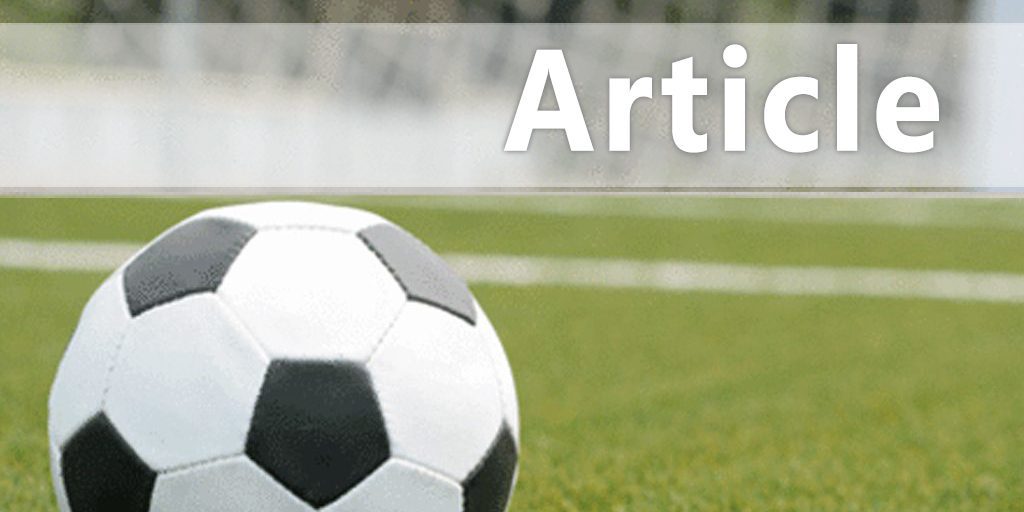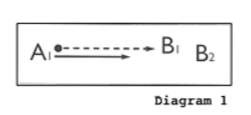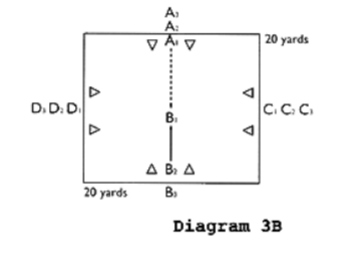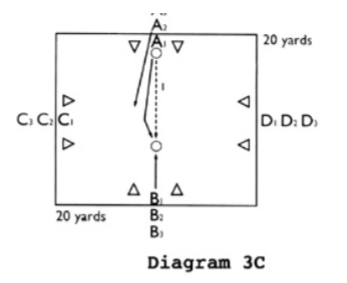| Individual Defending Exercise |
| By: Jeff Tipping- UEFA A License, USSF A License, Former NSCAA Director of Coaching Education
Provided by: Amplified Soccer All coaches want players who are aggressive on defense, but if this aggressiveness is not tempered with sound technical skills and tactical decisions, the aggressiveness can lead to breakdowns in the team defense. Common individual mistakes include a player overrunning an attacker rather than closing down and containing, players not tackling at the proper moment and a player reverting to slide tackling in the open field as a primary option rather than a last resort. Following is a practical session that addresses the individual skills of tackling, closing down and containing from the front and back -- as well as exercises that incorporate these skills into a team's defense. Warm-up Exercise Organization: Two players to a ball on either the end line or sideline. The warm-up will serve two purposes: preparing the player both mentally and physically for the session. The player will be introduced to tackling, closing down and containing -- while also getting his or her body acclimated to the physical demands of the session. To begin the warm-up, player A passes to player B and closes down on player B. Player B dribbles at A who backpedals, keeping the ball and player B in front until they return to the line. Then the players switch roles. Several pairs of players may be executing the same exercise simultaneously (see Diagram 1).
Player B should not be concerned with beating player A with a penetrating dribble at this point. The attacker is helping with the defensive warm-up. Although still a warm-up, the coach should stress to the defender the importance of moving quickly after playing the ball, but slowing down as he or she gets closer to player B. Young players especially have the tendency to overrun the offensive player. In the second stage of the warm-up, player A plays the ball between the legs of player B. As player B chases the ball down, player A closes down and prevents player B from turning (see Diagram 2).
Again, even though it is a warm-up, the coach should stress to player A the importance of keeping about an arm's length between him or herself and player B. In the final stage of the warm-up, the two players will work on block and poke tackling. Each player will stand about a foot from the ball. On the coach's command, both players will plant their left foot and follow through with their right foot to execute a block tackle. A second exercise is to reverse the roles of the feet. Next, the players will stand at an angle to the ball. On command, they will use the to of the front foot to knock the ball past the other player. Fundamental Stage Organization: Four cone goals, set on each side of a 20 x 20 grid. Players will be arranged into four lines (see Diagram 3A).
In stage one of the fundamental stage, player A1 passes to B1 and closes down from the front. B1 now attempts to beat A1 with the dribble and go to goal. When either a tackle is executed or a goal is scored, player C1 plays to D1. At the conclusion of the drill, players A and B switch places, as do players C and D. A key coaching point should be the importance of the defender closing down quickly, but slowing the approach as he or she nears the attacker. The defender should begin with long strides to cover the distance, employing smaller steps as he or she nears the opponent to slow down and become ready to defend. The defender wants to transform the attacker into a ball watcher. When the attacker is looking down at the ball, he or she cannot see teammates who may be open or have potentially better scoring opportunities. When slowed and in a position to pressure the attacker, the defender should adopt a sideways stance for several reasons. First, for proper block tackling, one foot must be planted for the follow through foot to make contact on the middle of the ball. With one foot in front of the other, the plant foot is set. The motion needed includes starting with a low center of gravity and following through with the other foot. With the feet set side by side, it would take two motions, first planting the foot and then following through, to execute the block tackle. Second, the player is in proper position to execute a poke tackle. The defender can use the toe of the front foot to knock the ball from the attacker. If the defender attempts the poke, he or she must be able to recover if the poke is unsuccessful. Third, if the defender is beaten, he or she needs only to turn 180 degrees to make a recovery run. Finally, the defender can channel the attacker to a second defender or towards the sideline, which itself serves as a defender. This makes the attacker predictable in regard to the direction he or she is moving. The main object is delaying. In a game situation, if the defender on the ball is able to delay the attack, it allows teammates to apply pressure to the attacker from the rear and also allows teammates to organize a collective defensive behind the defender on the ball. Another important coaching point at this stage is the timing of the tackle. The player should be within one step of reaching the ball, and should tackle the instant the attacker last touches the ball. Even with good tackling technique, a poorly timed tackling attempt can lead to a team breakdown.
The second stage involves A1 playing the ball to B1. B2 follows B1 and must prevent B1 from turning and scoring (see Diagram 3B). After play is finished with either a goal by B1 or a tackle by B2, A1 moves to the B line, B1 moves to the A line and B2 becomes B1 and will play the ball to A2, who will come to meet the ball and be challenged by A3. The C and D lines follow the same progression (see Diagram 3B). An important coaching point here is the necessity of the defender keeping the attacker's back to goal and his or her head looking down at the ball. When an attacker's back is to the goal, his or her view and options are limited to the back view. When his or her head is down, he or she cannot utilize other forward, more penetrating or dangerous options. A defender should prevent the attacker from turning and wait for the attacker to make the mistake. The defender should keep an arm's length and be in position to tackle if the attacker turns. If he or she is too close to the attacking player, the defender risks fouling or over-committing and allowing the attacker to move into open space with the dribble or a penetrating flick.
Stage three calls for a 1v2 situation. The tactics of individual defending now is combined with the concept of cover and balance. A1 passes the ball to B1 with A1 and A2 defending (see Diagram 3C). A1 is the first defender and A2 should be in a support position with proper angle and distance. The support angle should be 45 degrees on the side A1 is channeling the attacker. This position is taken so that A2 can be in position to tackle or close down if A1 is beaten. If t he support is too close, A2 could be beaten with the same touch as A1. If too far, A2 might not be able to make up the ground necessary to tackle or close down the attacker. The fourth and final stage calls for a 2v2 situation. Again, balance and cover are emphasized. In this case, A2 is still in a support position, but he or she also must be concerned with the second attacker, B2. If B1 does play the ball to B2, A2 must close down and becomes the first defender, while A1 adjusts and assumes a support position with proper angle and distance while still accounting for B1, who is now without the ball. After the A-B teams conclude the exercise, the C-D groups play. This gives each group a chance to reorganize and creates a good playing rhythm. |











